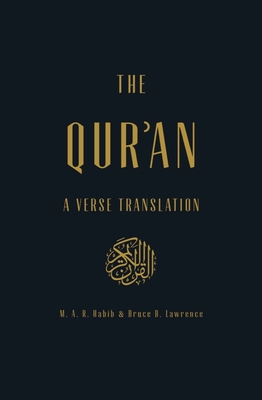The Qur’an: A Verse Translation
- By M.A.R. Habib and Bruce B. Lawrence
- Liveright
- 672 pp.
- Reviewed by Mike Maggio
- February 15, 2024
This poetic rendition of the holy text will appeal to nonbelievers, too.

Translation is a tricky business. Not only do translators need to get the words right, they also need to convey the linguistic, cultural, and often historical context of the original text. A single word or phrase may translate nicely into the target language but, in the original, have numerous connotations pertinent to the intent.
These aspects of language don’t always translate cleanly. Certain texts, such as scientific and news articles, translate more easily than others. Poetry adds a rich layer of complexity. And then there are religious texts like the Bible and the Qur’an, esoteric by their very nature and perhaps the most difficult to translate of all.
Witness, then, The Qur’an: A Verse Translation, by M.A.R. Habib and Bruce B. Lawrence. Habib, a professor of English at Rutgers, and Lawrence, professor emeritus of religion at Duke and adjunct professor at Ibn Haldun University in Turkey, spent 10 years collaborating on the most difficult of tasks: translating into English not only what is the basis of one of the world’s great religions but what is also considered the quintessential written example of the Arabic language.
One of the main questions that arises when approaching a translation of such complexity is why a new one is needed in the first place, especially when multiple versions already exist, including those of Sunni, Shia, Ahmadi, and other Muslim sects. And then there is the question of authenticity: How true to the original text is the fresh translation?
Habib and Lawrence approach these questions in their extensive preface, which includes a succinct summary of the history of Islam, a discussion of the general characteristics of Qur’anic text, and an introduction to the importance of recitation and performance. As they state, their intention was to make the English version easier to read and understand than previous translations and to provide an English-language rendition that is more in tune with modern poetic tradition. And so, they also include a discussion of English prosody, including aspects of stress and rhythm, accentual vs. blank verse, rhyme, and line length.
Why this emphasis on versification? As the authors point out, while the Qur’an is not poetry per se, recitation is part of the tradition that Muslims follow when approaching the text:
“The oral performance of the Book has been crucial from the earliest years…the devout Muslim must embody the knowledge of God by hearing, remembering, and performing scriptural directives, by becoming ‘a walking Qur’an.’”
Indeed, the Qur’an is recited more than it is read, and most Muslims learn at an early age to memorize it by mastering the rules of tajwid, a system of recitation which involves stops, starts, elisions, and nasality. Recitation of the Qur’an is, in effect, a performance which some in the Arabic world, including the late Sheikh Abdul Basit Muhammad Abdus Samad, have become known for. Why, then, should not the English version be rendered in such a way that would involve, if not recitation, then at least a flow of language akin to poetry?
Another goal was to provide clarity. Most translations of the Qur’an adopt (for lack of a better term) Biblical language, a stilted form of English most of us are familiar with. Here, for example, are two translations of the 105th chapter of the Qur’an, “Sura Al-Fil,” the older one on the left from the King Fahd Holy Qur’an Printing Complex, and the one on the right from Habib and Lawrence:
|
Seest thou not Did He not make And He sent against them Striking them with stones Then did He make them
|
Have you not considered
Did he not confound He sent against them pelting them with stones Then he left them |
The differences are obvious. The new translation is much more succinct and is rendered in language that is natural and limpid and, as the authors claim, “reads like English verse while retaining the deep structure of the Arabic text.”
Whether Habib and Lawrence’s translation becomes a standard for English-speaking Muslims like me remains to be seen. Nonetheless, their work should be of interest to everyone for the way in which it provides clarity, context, and beauty to — and renders into poetry — one of civilization’s most important texts.
Mike Maggio has translated Arabic and Italian poetry. His most recent project, available on his website, involves seven Italian poets in translation.

_80_120.png)